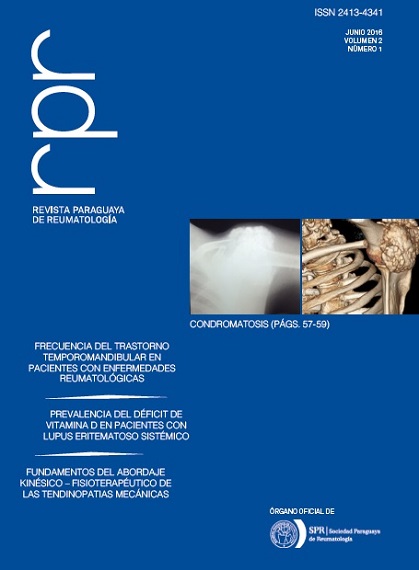Quality of life in patients with systemic lupus erythematosus
Abstract
Introduction: Quality of life seeks to encompass in a single concept the situation of an individual and their relationship with the environment in which they live, in addition to the socio-environmental interactions that influence their expectations, standards and projections. That is why it has led to the creation of surveys that seek to simplify unanimously satisfaction of people with their environment, the SF 36 being one used for this work, focused mainly on patients diagnosed with SLE and registered in the database of the cohort LUPUS PY. Objective: To determine the quality of life of patients diagnosed with SLE that are part of the database of the cohort LUPUS PY 2013-2014. Identify the correlation between disease activity evaluated by the SLEDAI, functional disability by HAQ and quality of life measured by the SF36. Methods: Analytical observational cross section study, including SLE patients from the LUPUS PY cohort who have completed specific questionnaires on disease activity (i.e. SLEDAI) disability (i.e. HAQ) and quality of life (i.e. SF36 ie their 8 members) between 2013-2014. Results: 57 patients were included, 89 % were women, the mean age of the cohort and age of entry to the cohort was 28.98 ± 10.94 years and 35.77 ± 11.44 years, respectively. The mean time from SLE diagnosis was 5.72 ± 6.20 years, 80.7 % of patients came from the Central Department and 36.84 % of patients had a higher education level. Family monthly average income was 2.456.521 ± 1.319.705 Gs. The mean SLEDAI score value was 2.83 ± 2.32. The media of the abbreviated SF36 components were 45.18 for the Abbreviated physical component (APC) and 47.71 for the mental component (AMC). No association and statistically significant correlation between the values of the APC and the AMC and the qualitative and quantitative variables analyzed were observed. In respect of the analysis between APC and AMC values and HAQ scores (disability) and SLEDAI (activity), a statistically significant negative correlation with the values of these scores and APC values were observed; with no significant correlation with the value of the AMC. Regarding the Score of SLICC (damage), a statistically significant negative correlation between the values of this score and the AMC was observed. Conclusion: This study found that the quality of life as measured by the SF36 for both their physical and mental component, is affected in patients with SLE. In addition, an association between disease activity, functional disability and damage to the quality of life in both the physical and mental component of patients was observed.Downloads
References
(1) Lemusa, N, Parradoa R, Quintana G. Calidad de vida en el sistema de salud. Rev. Colomb. Reumatol. 2014;21(1):1-3.
(2) Vilagut G, Ferrer M, Rajmil, L, Rebollo, P, Permanyer-Miralda G , Quintana JM, et al. El cuestionario de salud SF-36 español: una década de experiencia y nuevos desarrollos. Gaceta sanitaria. 2005;19(2):135-150.
(3) Gladman DD, Ibañez D, Urowitz MB. Systemic lupus erythematosus disease activity index 2000. J Rheumatol. 2002;29(2):288-91.
(4) Fortin, PR, Abrahamowicz M, Neville C, Du Berger R, Fraenkel L, C larke AE, et al.. Impact of disease activity and cumulative damage on the health of lupus patients. Lupus.1998;7(2):101-7.
(5) Stoll T, Gordon C, Seifert B, Richardson K, Malik J, Bacon PA,et al. Consistency and validity of patient administered assessment of quality of life by the MOS SF-36; its association with disease activity and damage in patients with systemic lupus erythematosus. J Rheu. matol. 1997;24(8):1608-14.
(6) Dobkin PL, da Costa D, Dritsa M, Fortin PR, Senécal J-L, Goulet J-R, et al. Quality of life in systemic lupus erythematosus patients during more and less active disease states: differential contributors to mental and physical health. Arthritis Care Res. 1999;12:401-10.
(7) Alarcón GS, Roseman JM, Bartolucci AA, Friedman AW, Moulds JM, Goel N, et al. Systemic lupus erythematosus in three ethnic groups: II. Features predictive of disease activity early in its course. Arthritis Rheum. 1998;41:1173-80.
(8) Mok, C. C., Ho, L. Y., Cheung, M. Y., Yu, K. L., To, C. H. Effect of disease activity and damage on quality of life in patients with systemic lupus erythematosus: a 2‐year prospective study. Scand J R heumatol. 2009;38(2):121-127.
(9) González-Rodríguez V., Peralta-Ramírez M. I., Navarrete-Navarrete N., Callejas-Rubio, J. L., Ruiz, A. M. S., Khamashta, M. Adaptación y validación de la versión española de una medida específica de la calidad de vida en los pacientes con lupus eritematoso sistémico: el Lupus Quality of Life. Med Clín. 2010;134(1),13-16.
(10) Pedroso B, Pilatti LA, Gutierrez GL, Santos CB, Picinin CT. Qualidade de vida: uma ferramenta para o cálculo dosescores e estatística descritiva do WHOQOL-100. Validacão dasintaxe unificada para o cálculo dos escores dos instrumentosWHOQOL. Conexões: Revista da Faculdade de Educacão Físicada Unicamp. 2011;9(1):130-56.
(11) Zheng Y, Ye DQ, Pan HF, Li WX, Li LH, Li J et al. Influence of social support on health-related quality of life in patients with systemic lupus erythematosus. Clin Rheumatol. 2009;28(3):265-9.
(12) Khanna S, Pal H, Pandey RM, Handa R. The relationship between disease activity and quality of life in systemic lupus erythematosus. Rheumatology (Oxford). 2004;43(12):1536-40.
(13) Araujo AD, Traverso-Yepez MA. Expressões e sentidos do lúpus eritematoso sistêmico (LES). Estud psicol (Natal). 2007;12(2): 119-127.
(14) Vilagut, G., Ferrer, M., Rajmil, L., Rebollo, P., Permanyer-Miralda, G ., Quintana, et al. El cuestionario de salud SF-36 español: una década de experiencia y nuevos desarrollos. Gac Sanit. 2005; 19(2),135-150.
(15) Vilagut, G., Valderas, J. M., Ferrer, M., Garin, O., López-Gacía, Alonso, J. Interpretación de los cuestionarios de salud SF-36 y SF-12 en España: componentes físico y mental. Med Clín. 2008; 130(19),726-735.
(16) Ariza, K., Isaza, P., Gaviria, A. M., Quiceno, J. M., Vinaccia, S., Alvarán, L., et al. Calidad de vida relacionada con la salud, factores psicológicos y fisiopatológicos en pacientes con diagnóstico de Lupus Eritematoso Sistémico-LES. Ter Psicol. 2010.28(1),27-36.
(17) Fernández, M., Calvo‐Alén, J., Alarcón, G. S., Roseman, J. M., Bastian, H. M., Fessler, B. J., et al (2005). Systemic lupus erythematosus in a multiethnic US cohort (LUMINA): XXI. Disease activity, damage accrual, and vascular events in pre‐and postmenopausal women. Arthritis & Rheumatism. 2005; 52(6),1655-1664.
Copyright (c) 2016 Paraguayan Journal of Rheumatology

This work is licensed under a Creative Commons Attribution 4.0 International License.









